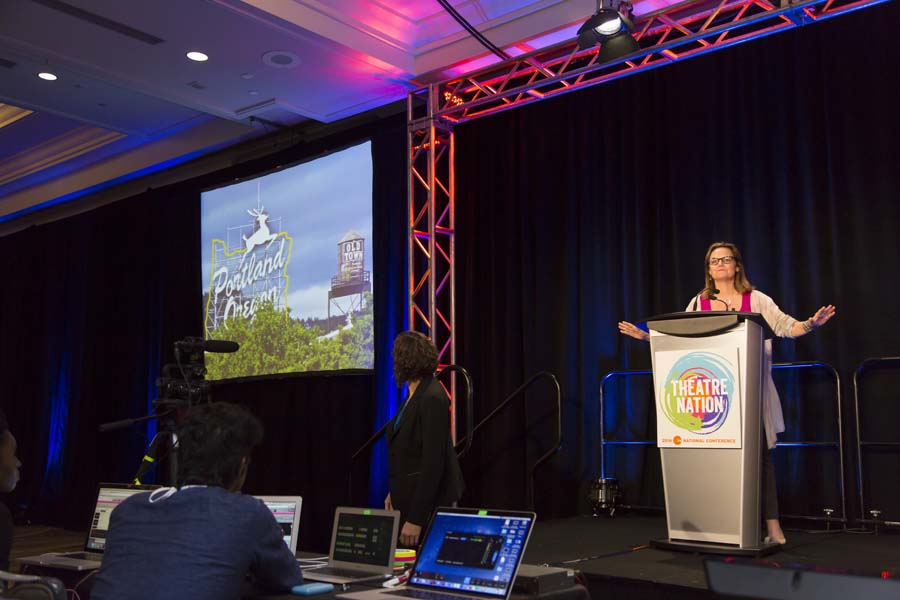As I write this column, I’m sipping a cup of Stumptown Coffee Roasters brew and admiring the scenery in Portland, Ore. I’m here for a series of meetings with our host committee and other community partners to plan TCG’s 2017 National Conference, which will take place next June in this thriving city pulsating with homegrown creativity. Portland is considered a “maker” town, the source of DIY beer, chocolate, pickles, bicycles, and just about anything else you can imagine.
And it’s a theatre town. From Portland Center Stage to Milagro, the city’s theatres produce new and classic plays, while also offering a myriad of programs to engage their communities. These strategies include, in the case of PCS, the decades-long practice of making the theatre’s lobby open to the public during the day—and the company holds the distinction of conducting the first historical renovation of a performing arts venue in the world to be platinum LEED-certified. (This column isn’t meant to be a conference pitch, but do mark June 8-10, 2017, on your calendars—we’re going to have a great time, with lots to see, do, and learn!)
Like so many of the theatre communities I visit nationwide, Portland is a testament to how our resident theatre movement has progressed. In cities and towns and rural areas across the U.S., our theatres create a strong, unifying sense of place; they become intricately interconnected with the individuals and entities that are the fabric of their specific locales. They also regularly tap into a national network of theatremakers to get the work done on stages, in classrooms, and beyond. When TCG member theatres come together for our annual convenings, we show up as representatives of those myriad, unique theatremaking ecologies—and also as one theatre nation that has grown up together. Those of you who were with us in Washington, D.C., this past summer know the power of that union.
I am also reminded that our progress is about leadership. The mission of a nonprofit theatre leader is not just to mount shows and fill seats, but to make their institutions relevant community hubs, even centers of civic engagement. (In this election season, we see that impulse in very specific ways—some theatres are serving as polling places or offering voter registration outside prior to curtain.) As we know from the annual Theatre Facts report, growth in audiences and funding streams is never a given, even in healthier economic times. To achieve continued success, the individuals who run our organizations must be adaptable and strategic—and they must be so day in and day out, year in and year out, no matter what is happening in the world.
Theatre leaders are regularly held publicly responsible not only for the success of what’s onstage but for the conversations that are generated as a result, plus the overall viability of the institutions they head (many of which are significant employers as well as purveyors of theatre and education programs). These dynamics extend beyond our larger or more established entities—in a place like Portland, there are also countless smaller startup companies that serve very specific communities and are connected in rich and meaningful ways into the local scene.
When I entered the nonprofit theatre field decades ago, I was interested in making the arts central to community life. I believed that art and art-making had a distinctive capacity to spark conversation and connection among people of all backgrounds and beliefs. For me, the communal, collaborative act of coming together in theatre was particularly powerful. This personal mission took me from college to D.C.’s Woolly Mammoth Theatre Company, where, as development director, I encountered the unique challenges of raising money for a small startup that sought to be a leader not only through the work onstage but beyond. My job was about getting people interested in and excited about not just a single play but a mission. It was about building and sustaining commitment to an organization for the long haul. It’s gratifying all these years later to see the trajectory of Woolly Mammoth and its significant role in D.C., a city that has grown dramatically as a theatre center since I got my start there.
Brannon Wiles’s article in this issue, “Same Job, Different Business,” about the similarities of producing in commercial and nonprofit contexts, reminded me of my days in the theatre administration program at Yale. My teacher and mentor was Ben Mordecai, who was both a nonprofit producer (as managing director of Yale Repertory Theatre) and a commercial producer (as the driving force behind the proliferation of August Wilson’s plays, which were “production shared” in resident theatres across the country before arriving commercially in New York City). Ben enjoyed taking students along with him to see how Broadway shows came together. But he was also very clear about the ultimate purpose of Yale’s theatre administration program: It was, ideally, to become skilled as a nonprofit resident theatre leader. In his mind, that was both a different skill set and a different mindset.
As we move toward what promises to be a landmark National Conference in Portland, I look forward to exploring these and other topics essential to the work of building a sustainable system of theatremaking for us all.


